Matador Network's Blog, page 2290
April 3, 2014
The 32 best Airbnbs in Rio
Space is clearly limited in Rio. Even the more expensive apartments are tiny by many standards, with bathrooms resembling closets and kitchens resembling hallways. Beds are squeaked in wall-to-wall. The magic is in those that manage to take the space they have and turn it into something more, through excellent and beautiful curation.
Here are some of the best Airbnbs to stay in while visiting Rio de Janeiro.
The ultra cush
$3555/night • Rua República do Peru, Rio de Janeiro, Rio de Janeiro 22021-040, Brazil

(via)
One of the most expensive Airbnbs I could find in Rio, this place is like the slightly-more-upscale version of the next listing. That said, oh my god, that bathroom. You know the one, with its black marble Jacuzzi. Also, Andy Warhol gallery. ‘Nuff said.
$3081/night • Rua Pompeu Loureiro, Rio, Rio de Janeiro 22061, Brazil

(via)
There are at least two major components of this listing I’m going to mention. First and foremost, spiral staircase. I love them; I can’t help myself. Secondly, flippin’ glow pool. With light-up bar and water curtains.
$2500/night • R. Santa Gláfira, Rio de Janeiro, Rio de Janeiro 22610-300, Brazil

(via)
This place, with its wonderful wooden doors and colorful kitchen, is the exact thing I fantasize about when I imagine getting away from the grey of Portland and escaping to some faraway magical not-Portland. I wish I were kidding, but I seriously honest-to-god believe I’ve dreamed of this place, down to the cow clock in the kitchen.
$2495/night • Rua Jackson de Figueiredo, Rio, Rio de Janeiro 22611, Brazil

(via)
Every single photo looks like it was taken from a different movie. First one is clearly Jurassic Park. Second one is the set of every soap opera ever. Third one looks like Forgetting Sarah Marshall. I’m going to skip the dining room because it’s boring, but the fifth one looks straight out of The Princess Bride. And so on, and so forth. What would you pay to live in a bunch of different movies for the weekend?
$1405/night • R. Vinícius de Moraes, Rio de Janeiro, Rio de Janeiro 21072-540, Brazil
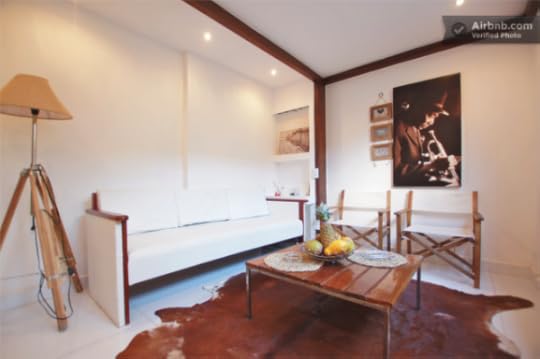
(via)
Sadly, this listing taught me something new, and even more sadly it had absolutely nothing to do with Rio and its neighborhoods. Instead, I now know that SONOS is a thing which exists, and when comparing the price of the unit to the price of this rental, I may have to get one of those and just pretend I’m at this place instead.
$1276/night • Rua Nascimento Silva, Rio, Rio de Janeiro, Brazil
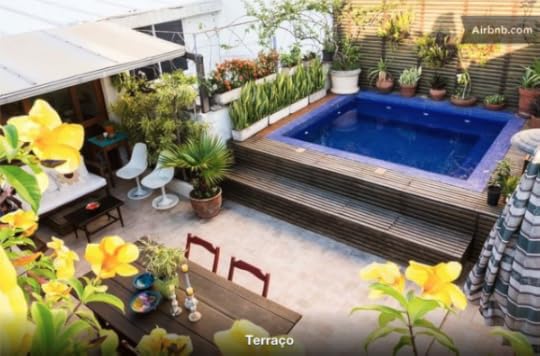
(via)
There’s one in every batch — the apartment or home that looks as though the professional design and marketing team for a home furniture store designed it. Literally every single room of this looks like it was copied and pasted from a home-design site. Places like this don’t really exist outside the contrived magazine setting this was so blatantly ripped from, so that would be the obvious bonus to shelling out the 1.2 Gs to visit it.
$8822/wk • R. Gen. Urquisa, Rio de Janeiro, Rio de Janeiro 22431-040, Brazil
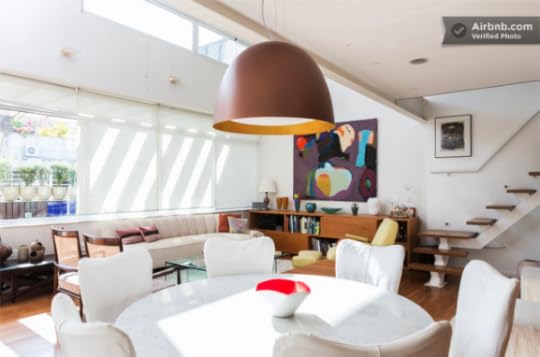
(via)
The offerings for this place are as extensive as they are, indeed, grand. However, I can’t read or comprehend any of them because the clause “…is equipped with swimming pool, steamed sauna, and barbecue settings…” might as well be bold, underlined, italicized, and put into size 100 font. I can’t see anything else, nor would I want to.
$1093/night • Estrada da Gávea, Rio, Rio de Janeiro 22451, Brazil
[image error]
(via)
This house, from its crisp edges to its poured-concrete countertops, is artsy as hell, but it’s also clearly well thought out, and there’s a place for everything (including flip-flops, evidently). It’s the kind of neat that straddles the line between appealing to my mild OCD and taunting me to touch something I’m not supposed to. ‘Great House in Gavea,’ you are a wonderful tease, and if I could afford it I would stay in you in a heartbeat.
$1000/night • Rua Antônio Basílio, Rio, Rio de Janeiro 20511-190, Brazil

(via)
Take a gander at this incredible apartment: four bedrooms, accommodations for 10, 3D 50” television, 30Mbps internet (dwarfing the paltry offerings I have from my current ISP), and a big-ass sliding door. Also, that kitchen. I would live in that apartment just about anywhere.
$937/night • Avenida Rainha Elizabeth da Bélgica, Rio, Rio de Janeiro 22081-031, Brazil

(via)
This place looks pretty much identical to every Kidrobot store I’ve ever seen, from the color balances, to the lighting, and even to the decor (some of which I’m 80% certain actually came from Kidrobot). So modern and sleek, this place is probably as expensive as it is because of how massive it is by Rio standards.
The midrange
$360/night • Rua Francisco Sá, Rio de Janeiro, Rio de Janeiro 22080-010, Brazil

(via)
Holy crap, look at this place! “Projector with hand-painted mural off to the right,” pretty much says it all. That, and a bed-facing, ceiling-mounted TV. I could die there happy, by which I mean I can afford to spend one night there, and hopefully I’ll just die during that night.
$260/night • Rua Alberto de Campos, Rio de Janeiro, Rio de Janeiro 22411-030, Brazil

(via)
This place sort of reminds me of a futuristic diner from the ‘80s. It’s probably the stools. Yes, the washing machine is seamlessly integrated into the rest of the kitchen appliances, and, yes, one of the bedrooms looks a bit like a woodland cabin, but the marble-inlayed Jacuzzi tub in one of the three bathrooms made me reconsider. Plus, with three rooms (two of which are luxury suites) and accommodations for eight, this place is a steal at $32.50 provided you’ve got seven other friends to split it with.
$250/night • Av. Atlântica, Rio de Janeiro, Rio de Janeiro 22070-000, Brazil

(via)
This place is awesome, super modern, and super dangerous. The danger comes from being that close to the beach and being that white on every surface. You’re obviously going to get sand everywhere, and it’s going to show.
$167/night • Rua Visconde de Pirajá, Rio de Janeiro, Rio de Janeiro 22410-001, Brazil
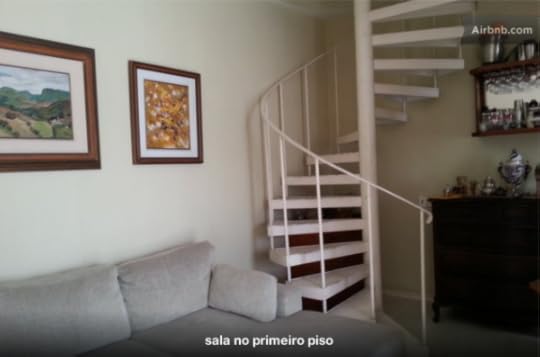
(via)
Spiral staircases weirdly stuck in the middle of the living room, batman! Though this place is somewhat unremarkable, as far as penthouses go, the view alone pretty much justifies the price tag. (Not to mention security, double bedrooms, and sauna access. Like no big deal.)
$154/night • Rua Duvivier, Rio, Rio de Janeiro 22020-020, Brazil

(via)
This is basically an upscale hotel, complete with TV, doorman, 24-hour concierge service, the whole nine. The difference, however, is that you do have to cook your own meals, but at least you can cook them in the fully equipped kitchen.
$142/night • Rua Desembargador Alfredo Russel, Rio de Janeiro, Rio de Janeiro

(via)
It’s as charming as it was obviously furnished by hipsters. However, between the two bedrooms and living room full of intriguing doodads and tasteful art selection, this place is not a bad choice for a grownup holiday.
$132/night • R. Barata Ribeiro, Rio de Janeiro, Rio de Janeiro 22040-002, Brazil

(via)
This two-bedroom apartment two blocks from the beach sleeps five for one price, with only $13 a night for every guest thereafter. That’s an incredibly affordable $26.20 per person a night for those 5 guests, to stay in an apartment a stone’s throw from a beach in Rio.
$118/night • Av. Gen. San Martin, Rio de Janeiro, Rio de Janeiro 22441-015, Brazil
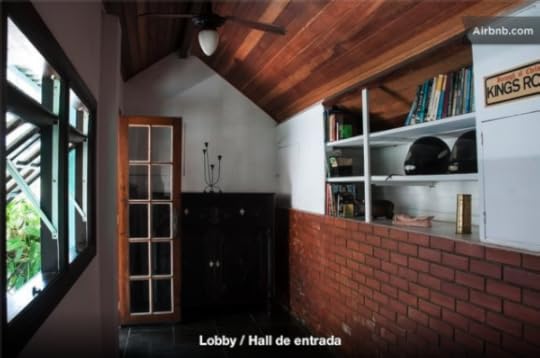
(via)
This self-proclaimed “photographer’s loft” is pretty sweet in and of itself, but the gem in this listing is the included photos of the neighborhood, from the dope discotheque to the 24-hour pizza and beer lounge. I’d never want to leave.
The cheap
$90/night • R. Alm. Alexandrino, Rio de Janeiro, Rio de Janeiro 20241-265, Brazil
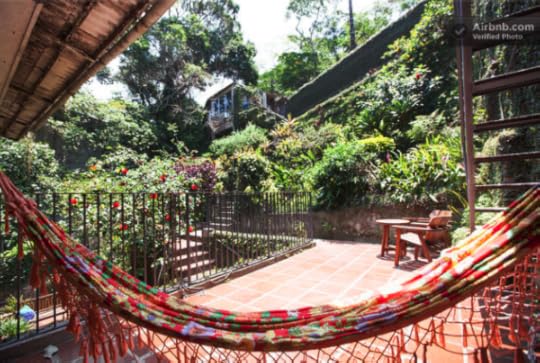
(via)
I want to go to there. It’s like a jungly refuge, the perfect hideout to meet my agent contact and pick up the dossiers for our next mission. Okay, so maybe the ragdolls and fuzzy pillows read less ‘secret agent’ than the exterior and surroundings, but this place has an unbelievable amount of space for Rio, so sprawl out while you can!
$80/night • R. Raimundo Correia, Rio de Janeiro, Rio de Janeiro 22040-040, Brazil

(via)
Okay, so full disclosure — I’m a sucker for purple, and this place has it in spades. Aside from that, however, it’s also pretty cute and has all of the amenities you’d expect, with the added bonus of fluent English-speaking hosts. Sure, it only has five reviews, but five stars means they’re doing something right!
$74/night • R. Joaquim Murtinho, Rio de Janeiro, Rio de Janeiro 20241-320, Brazil

(via)
This place is all about workflow. It’s got a desk, and you get to crash in a freakin’ hammock. I imagine myself swaying gently while trying to brain my way through my next track, or seeking inspiration while staring out the window. Then, when it strikes, I’ll sit up too fast, and the hammock will dump me on the floor. I’ll curse it and everything about everything but get to the desk in time to take down some notes.
$70/night • Rua Santa Luzia, Rio de Janeiro, Rio de Janeiro 20020-021, Brazil
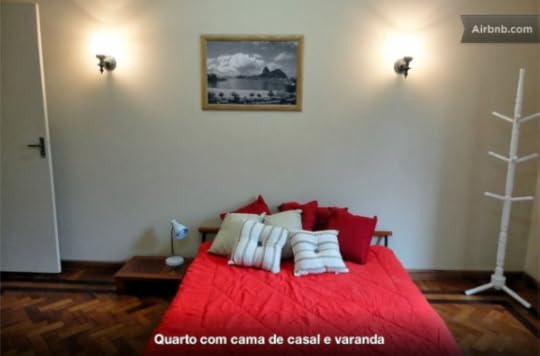
(via)
First and foremost, I love the wee sitting area. It would be the perfect place to enjoy a little espresso and nurse the Brazilian hangover from the night before. The tile work around the mini kitchen is killer, and with comments about the “charmous”-ness of the place, how could you not want to stay here?
$70/night • Estrada do Vidigal, Rio de Janeiro, Rio de Janeiro 22451-090, Brazil
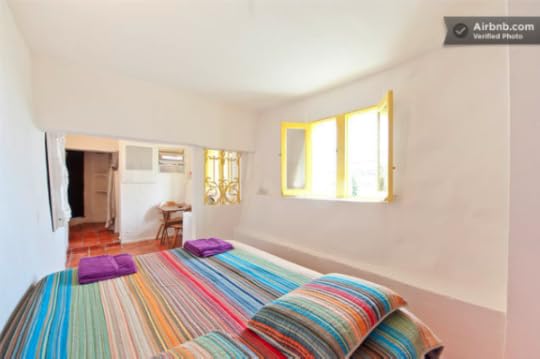
(via)
I’m really into the decor in this place, especially the pulled-back-curtain-revealing-batcave-entrance closet in the bedroom picture. It’s like a magical boho princess studio, full of light and primary colors. It’s important to note, however, that there’s no kitchen, so take that into account and plan to eat out for every meal.
$70/night • R. Santo Amaro, Rio de Janeiro, Rio de Janeiro 22211-230, Brazil

(via)
It’s sparse and furnished with toys, but this place has all the bare necessities (namely, a place to sleep and a bunch of toys). Fun fact: Carioca is a Brazilian adjective or demonym used to refer to the native inhabitants of the city of Rio de Janeiro.
$69/night • Rua Aires Saldanha, Rio de Janeiro, Rio de Janeiro 22060-030, Brazil
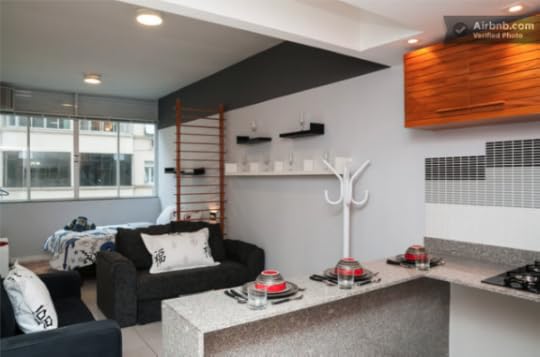
(via)
This ultramodern greyscale space is absolutely ideal, given the price. Sure, it’s a tad small, but then again so is everything in Rio, and I personally can’t get over how awesome the decor in the kitchen is, especially the backsplash that resembles an equalizer.
$65/night • R. Barão de Guaratiba, Rio de Janeiro, Rio de Janeiro 22211-150, Brazil

(via)
This place has solid beach house vibes and a very back-to-basics feel, but when I saw “quiet house” I couldn’t help but think about my dad. My dad is the kind of person who would complain if he heard any street noise whatsoever and expect to be moved to the top floor opposite the penthouse suites where the air is thin and the noise is nonexistent. Dad, this one’s for you.
$58/night • Rua Taylor, Rio de Janeiro, Rio de Janeiro 20241-060, Brazil

(via)
Arty and cosy indeed, this cute and colorful crib comes complete with a heap of bikes (though they’re mostly kids’ bikes) and makes for a killer package. The comments make me more than optimistic about the quality of this Airbnb, and at $58 a night it’s hard not to see this as an ideal option for your trip to Rio.
$37/night • Rua Orestes Barbosa, Rio de Janeiro, Rio de Janeiro 21940-375, Brazil

(via)
With ‘good vibes’ in the name, it’s hard not to want to stay here, especially with mentions of a ‘baby pig’ in the comments (which I cling to as a literal description, despite the photos of a tiny dog). Seated in a prime location, and with a host who gets solid reviews, this would be a great choice for a budget first-timer.
$31/night • Rua Joaquim Murtinho, Rio de Janeiro, Rio de Janeiro 20241-320, Brazil

(via)
Yes, it’s literally little more than a bed and a bathroom, but for $31 a night this is the ideal foothold in Rio if you’re on a budget. Plus, there are certainly worse things after a night of drinking than being able to crawl out of bed and be immediately in the bathroom.
Honorable mentions
$2501/night • Avenida Infante Dom Henrique, Rio, Rio de Janeiro, Brazil

(via)
C’mon, it’s a yacht.
$132/night • Rio, Rio de Janeiro 22420-040, Brazil
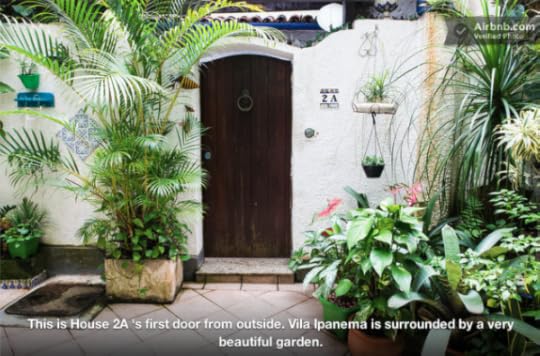
(via)
It may not be up to the same luxury standard as many of the other places, but this place is a serious find. It’s a whole house, with a covered porch and air of authenticity as “one of the last houses of Ipanema neighborhood.” It would be a standalone experience staying at this place, which is why it’s on the honorable mentions list.
$25/night • Rua Riachuelo, Rio de Janeiro, 20230-013, Brazil
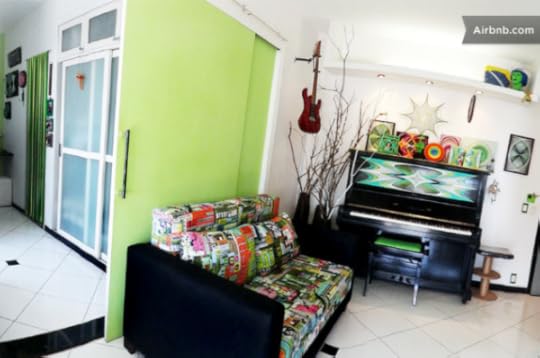
(via)
Sure, it’s literally a listing for a couch-bed in some artsy hippie chick’s apartment, but for $25 a night I’d crash there, and it seems like a pretty good, well-priced foothold in Rio. Plus, the reviews are in, and she seems super nice. Definitely a top honorable mention. 
The post The 32 best Airbnbs in Rio de Janeiro appeared first on Matador Network.

There are like, no wild mammals left

Infographic: xkcd
Randall Munroe, the creator of the popular webcomic xkcd, recently did this infographic showing the total weight of all the land mammals on Earth. While it should be noted that, using this scale, each square is a million tons, what I found most incredible about this was the proportion of humans and domesticated animals to wild animals. There are so few of them. Munroe points to a single box and designates them as elephants, the animals that the English language has made synonymous (“elephantine”) with “huge” or “heavy.”
It’s worth pointing out that, had Munroe included non-mammalian species, Antarctic krill would have had five times the total biomass of humans, and bacteria as a whole would outweigh us by a factor of thousands. In the context of Earth’s mammals, though, this just goes to show what an incredibly huge effect we’ve had choosing which species get to inherit the Earth. 
The post There are like, no wild mammals left anymore appeared first on Matador Network.

How to piss off a Romanian

Photo: János Csongor Kerekes
Mistake Bucharest for Budapest.
Never ask a Romanian if he lives in Budapest. That’s the capital sin, the perfect way to end a potentially interesting conversation. Yes, Budapest is a capital city, and there’s a big chance you’ll nail it with this guess — but only if you’re speaking to a Hungarian! We’re so tired of hearing, “Good evening, Budapest!” every time an international act has a concert in Bucharest. Metallica did it, Lenny Kravitz did it. And many others. But they had bodyguards.
You, on the other hand, will be alone in front of an outburst of anger.
Ask us about vampires.
In 1897, the Irish writer Bram Stoker published a Gothic novel entitled Dracula. His story made Transylvania more famous than any tourism promotion campaign ever could. By using some historical facts, he linked Vlad Tepes, the Voivode of Wallachia, to his main character, Count Dracula, the vampire.
Unfortunately, that means foolish tourists now come to Transylvania expecting to see garlic hanging by doors or people walking around with wooden stakes in their pockets. Transylvania is a peaceful, hilly area with many traditional houses and fortified churches. The real threat back then wasn’t exsanguination, but impalement — the Voivode Vlad’s favorite method of execution. And that isn’t fiction.
Leave food on your plate.
Mark my words: If invited to a Romanian’s home for lunch or dinner, fast for a day or two before the visit. We are known for being a welcoming nation, and one of our favorite ways of showing it is through food.
Here are a few appetizers so you don’t starve before the first course is ready. Some eggplant salad, salted roe, homemade smoked bacon with onions, and stuffed boiled eggs with mayo. Come on, try them all! Do you like the smell of our meatball soup? Here comes the clay pot full of sarmale, next to a steaming polenta and a jar of cream. You have to taste this! It’s our traditional course. You’ve finished everything? Don’t worry, there’s plenty more! The pork roast seasoned with garlic is almost ready.

More like this: How to piss off a Lithuanian
Show any signs of slowing down and your host will say, “Whaaat, you don’t like my food?” You might think, Jeez, I’m eating like a maniac — what’s this woman talking about?! And then comes the explanation from the genuinely upset cook: “I can see a tiny bit of sarmale left on your plate.”
Confuse Romanians with Gypsies.
The official name of the Gypsy ethnic group is Romani, and even though Wikipedia states they are “not to be confused with Romanians, an unrelated ethnic group and nation,” misplaced associations are still often made. There are Gypsies all over the world — one million in the United States, 800,000 in Brazil, and many others in Europe, including Romania. They originated in India and left sometime between the sixth and eleventh centuries. Confusing Romanians with Romanis only makes you sound ignorant.
Tell us a breeze can’t make you sick.
We Romanians are so convinced that a cool breeze or draft of air can make you sick that we even have an expression for it: Te trage curentul. (“You’ll be pulled by the draft.”) Take the bus on a hot summer day, and you’ll probably see the windows open on only one side of the vehicle, or not at all. Craving a breath of fresh air, you move your hand in the direction of the window. But even before you touch the handle, you’ll hear a panicked voice say, “Are you trying to get us all sick?”
To anyone else, this doesn’t make sense, but the logic behind this Romanian belief goes like this: The current of cool air will make your ears hurt and your nose run. Don’t even try to argue about this. You’ll only make yourself hotter.
Refuse homemade beverages.
Romania has one of the oldest winemaking traditions in the world. The country once had so many vineyards it’s believed Dionysus, the god of wine, was born in southeast Romania in a region then called Thracia.
As proud successors of the Thracians, Romanians practice winemaking as a popular hobby, so you’ll probably be offered some garage-made wine. Or tuica, a strong fruity beverage.
Even if you have reason for concern, do not ask about hygienic conditions or quality control. We take great pride in everything made with our own hands, so turning it down would be a serious insult. Take a sip, two, three, and worry not. We all drink homemade alcohol, and no one has died of it. So far. 
The post How to piss off a Romanian appeared first on Matador Network.

April 2, 2014
Terrifying vid of an 8.3 earthquake
FROM Matador staffer Scott Brannon:
I lived in Lima for three years and for the last two there was literally an earthquake every three weeks. It started driving me crazy and they became more and more terrifying even when they were small (which they all were, but you still felt the shit out of them).
When you think about the construction of the buildings in that part of the world, there is zero wood: It’s all cinder blocks, cement, and re-bar with heavy poured concrete floors above and below you.
The latest reports are of five dead and hundreds of thousands evacuated due to tsunami warnings. A state of emergency has been declared and troops have been deployed to the hardest hit areas. 
The post The terrifying reality of Chile’s 8.2 earthquake caught on video appeared first on Matador Network.

20 facts about Disney World

Photo: Jarkko Laine

Photo: Dancingnomad3

Photo: chensiyuan

Photo: Jeffrey Zeldman

Photo: Cory Doctorow

Photo: Paul Beattie

Photo: Richard Stephenson

Photo: Josh Hallett

Photo: Randy Pertiet

Photo: Josh Hallett

Photo: Danny Thompson Jr.

Photo: AreteStock

Photo: Lou Oms

Photo: Michael Gray

Photo: bdesham

Photo: Candace Lindemann

Photo: bdesham

Photo: Miramar93

Photo: Michael Gray

Photo: Michael Gray
[Feature photo: Peter Lee]
The post 20 things you may not know about Walt Disney World appeared first on Matador Network.

26 futuristic gardens & green spaces
With cities taking up more space on the planet than ever, communities are struggling to solve problems of food security, climate control, and how to make our concrete jungles look a little more…well, jungle-like.
These amazing inspirational farms show that urban farming can pave the way to real change in the future. 
[image error]
1
Cloud Mountain – Singapore
One of the centerpiece gardens of Singapore's Gardens by the Bay (see #9 below) is "Cloud Mountain," with a circular pathway ascending its nearly 140 feet. Not pictured on the backside is a waterfall. The entire structure is covered in epiphytes such as orchids, found in tropical mountain regions of Southeast Asia and South America.
(via)

2
Gardens at Marqueyssac – France
An oldie (1860s) but a goodie, these elegant gardens in the Dordogne region may be the world's original futuristic green space. Thousands of boxwood and cypress trees are planted in brilliantly trippy arrangements that boggle the mind.
(via)

3
Parkroyal Hotel – Singapore
This hyper-modern luxury hotel has over 15,000 square meters (and six levels) of sky gardens, which are cantilevered between blocks of hotel rooms and feature waterfalls and reflecting pools as well as local flora.
(via)

See more like this: 6 of the world’s most ingenious wildlife overpasses

4
Acros Building – Fukuoka, Japan
15 stepped terraces contain an amazing 100,000-square-meter park perfect for lunch-break meditation sessions.
(via)

5
Vancouver Library Square – Vancouver
Library Square is a gorgeous compound featuring a beautiful rooftop garden and a massive glass atrium that helps blur the line between inside and outside.
(via)

6
Athenaeum Hotel – London
This eight-story vertical garden harbors a diverse ecosystem of plants, insects, flowers, and birds right in the heart of downtown London.
(via)

7
Nanyang University – Singapore
A sweeping, walkable green roof rolls across the five-story Nanyang University campus.
(via)

8
High Line Park – NYC
Built on an abandoned rail line elevated above the streets of Manhattan’s West Side, High Line is a one-of-a-kind urban space for strolling, jogging, and relaxing.
(via)

9
Gardens by the Bay – Singapore
A futuristic park / garden in Singapore, the entire area is built on reclaimed land.
(via)
Intermission
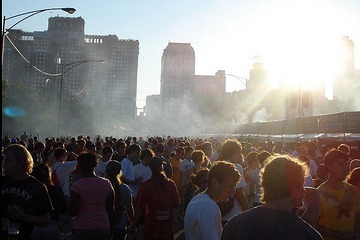
U.S. summer music festivals gone green

Green to the extreme?

Alaias: How an old-school board is making surfing greener
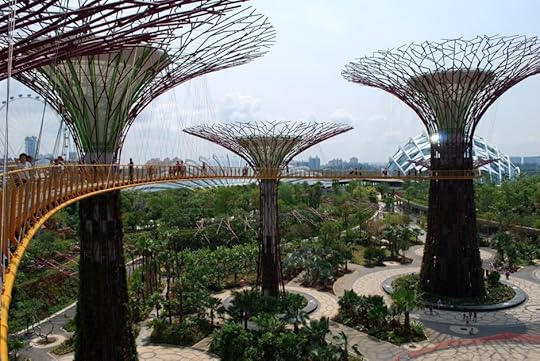
10
Supertrees – Singapore
The Baobab-like "Supertrees" in Gardens by the Bay "mimic the ecological function of trees – photovoltaic cells that harness solar energy which can be used for some of the functions of the Supertrees, such as lighting, just like how trees photosynthesize; and collection of rainwater for use in irrigation and fountain displays, exactly like how trees absorb rainwater for growth. The Supertrees also serve air intake and exhaust functions as part of the conservatories' cooling systems."
(via)

11
Hotel Reina Roja – Cozumel, Mexico
Reina Roja's rooftop bar and pool is surrounded by plants, trees, and flowers in pots and planter boxes.
(via)

12
Public Farm 1 – Queens, NY
Technically an art installation celebrating urban farming, P.F.1 features a chicken coop and a juicing station. The entire installation is solar-powered.
(via)
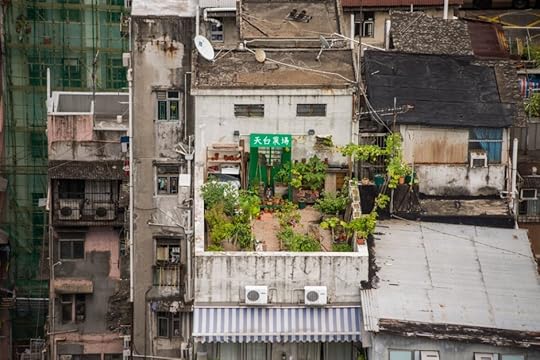
13
Yau Ma Tei Farm – Hong Kong
HK Farms collaborates with local communities to build rooftop farms. A group of artists, designers, and farmers, they specifically encourage local produce to reduce carbon footprint.
(via)

14
Ngau Tau Kok Farm – Hong Kong
Another HK Farms mini-farm, this 4,000-square-foot rooftop in an industrial neighbourhood grows herbs and vegetables and opens to visitors on weekends for guided tours.
(via)

15
Garden of Cosmic Speculation – Scotland
If you put Gandalf, Timothy Leary, Willy Wonka, and the Mad Hatter into a room with their mind-altering substances of choice and told them to design a garden – this would be that garden! And it's only open one day a year so, yeah, plan accordingly.
(via, via, via)
Intermission

10 steps hotels can take to go greener

DIY plumbing: Green ways to clean a drain

Is there a green lining in the economic cloud?

16
California Academy of Sciences – San Francisco
The massive green roof prevents two million gallons of rainwater from becoming storm runoff every year.
(via)

17
Chicago City Hall green roof – Chicago
This rooftop garden in the heart of downtown was planted in 2000 and is mostly prairie plants native to the Chicago region. It reduces heating and cooling costs for City Hall and retains 75% of an inch of rainfall before entering the storm drains.
(via)

18
Namba Parks – Osaka, Japan
Amidst the bustling urban sprawl of Osaka, the Namba Parks offers eight stories of natural sanctuary with groves of trees, clusters of rocks, cliffs, lawn, streams, waterfalls, ponds, and terraces.
(via)

19
Vancouver compost garden – Vancouver
Originally developed in 1982 to demonstrate how much food could be grown in a city yard, this pesticide-free farm turned its attention to composting in 1990. It's run by nonprofit group City Farmer.
(via)

20
Pasona 02 – Tokyo
Built in a series of converted bank vaults, this urban underground farm was developed to provide agricultural training to the unemployed or people interested in switching jobs. Because it is underground, Pasona 02 uses artificial lights and hydroponics to grow crops.
(via)

21
Vertical flower garden
Whether it's a living wall or a literal "tower of flowers," vertical gardening is gaining popularity in urban environments because of the way it maximizes space.
(via)

22
Vancouver Convention Center – Vancouver
The six-acre living roof atop Vancouver's convention center is filled with native plants and hosts several hives of honeybees, whose honey is used in the center's catering facilities.
(via)

23
O'Hare Airport garden – Chicago
Twenty-six towers hold over 1,100 plants in this vertical garden in Chicago's O'Hare International Airport rotunda. It uses no fertilizers or chemicals and nutrient solution is regularly cycled through the plants to prevent water evaporation waste.
(via)

24
Ballard Library – Seattle
Complementing the design sense of the neighborhood's traditional Scandinavian and maritime roots, the Ballard Library's green roof contains solar panels and 18,000 plantings.
(via + via)

25
Comcrop – Singapore
A 6,000-square-foot urban farm on a downtown rooftop, Comcrop is one of the first farms in Singapore to use vertical farming and the first to use aquaponics, a combination of aquaculture (farming fish) and hydroponics.
(via)

26
Awaji Yumebutai – Hyogo, Japan
Built to restore the natural environment after earth from the area was removed to create manmade islands in Osaka Bay, Awaji Yumebutai is surrounded by native flora of Awaji Island.
(via)
The post 26 futuristic urban farms and green spaces [pics] appeared first on Matador Network.
Why musicians are the best travelers

Photo: Volker Neumann
A party is one musical note away.
A cold, rainy day in Hanoi. Stuck in the hostel with little to do, you decide to put your feet up in the lobby. Your new travel companion appears, guitar in hand. You ask him to play a song. He obliges. You watch his hands move, picking with the accuracy and precision of a dart player.
You look back up, only to find a crowd gathered around you. A Bia Hà Nội, the local beer, is passed to you. The music gets louder, as does the crowd, drinks in hand. You find yourself holding a bottle of rice whiskey at some point in the evening.
The next thing you know, you’re waking up in your dorm with a giant headache — but you know you had a good time. And after doing some detective work to piece together the rest of the evening, you find out everyone else did too.
Music is the universal language.
You find yourself asking lots of questions about this six-stringed device. You learn to play your first song — a simple, recognizable tune.
Days later, you come across someone you’re attracted to, but you have trouble communicating. You point at your friend’s guitar. Your new love interest nods. You play. The song ends and she claps. Using your broken Spanish and makeshift sign language, you hint towards having a meal together. She nods again.
Touring is the ultimate preparation for budget travel.
Much of your time is spent in transit. Every other day you’re having trouble sleeping — on a plane, sleeper bus, van, you name it. Every time you peer over, your musician friend is sound asleep. He might as well be back home in a queen-size bed.
You ask how he’s able to sleep so well in any situation. You’re told that spending months at a time traveling from city to city in a muffler-less “tour van” makes a plane feel like a five-star hotel.
Running out of money is a temporary problem.
You and your new partner-in-crime are running low on funds. You fear having to spend your last dollars on buying a plane ticket back home. You’re told to “breathe and relax” — the situation will be “figured out.”
You accompany him from bar to bar around the city as he asks bartenders and doormen questions. Finally, you see him walk out of a bar with a smile: He booked a gig for the night. You spend the evening watching him entertain, playing cover after cover. You watch as people drop tip after tip into your friend’s hat.
Boredom is an excuse to create.
Every so often, boredom hits you while on the road. Today, you have three hours to kill before your seven-hour bus ride. You pace around the bus station trying to find something to do. All your electronics are out of batteries.
Your musician friend, pen and paper out, is scrawling at a hasty pace. You remain quiet and observe. You ask what he’s doing. “Writing music.” You sigh. You’re told to give it a try yourself. 
The post 5 reasons musicians make the best travelers appeared first on Matador Network.
Inside Korea's abandoned buildings

The reception desk of an abandoned hotel. Even the pool table has been left behind. All photos: Author.
When alone in nature, your world is at peace. Everything is calm, and the forest is your friend because you feel as if you’re the only person to have ever walked the path before you.
When alone in an abandoned building, those feelings are reversed. Why is this building here, why is it abandoned, who might still be lurking in the dark shadows? There’s something sinister about a structure that was obviously erected at great expense, then simply left unused.
An abandoned hotel movie set
On the island of Jeju, the ‘Hawaii of South Korea,’ I heard about an abandoned hotel movie set. I couldn’t resist checking it out for myself. Excitedly, a few friends and I bundled into the back of a minivan and went in search of this elusive structure. A short while later, we spied a grand castle-like building from the main road. Could this really be it?
Dodging some barbed-wire fencing and pushing our way through thick foliage, we made our way towards the towering, elaborate beast. What we found blew our minds. We were greeted by a structure adorned with fine detailing, and on the grounds were both water features and a swimming pool.
Like kids on Halloween, we rushed around, drinking in the visual candy. One of the doors was open, so we took this as an opportunity to explore inside. There we found pianos, beds, a bar, and one hell of a lot of everything else. Lighting equipment worth thousands of dollars had simply been left behind, and the whole space could’ve served as a real hotel if there’d been staff…until we realised the towers were mock features with no access, there were no actual bedrooms, and some doors opened onto nothing. I felt like a ghost exploring a sacred and hostile place — no one knew we were there, no one else existed in the world.

Our first view of the abandoned hotel movie set. The creators even took the time to install water features.

The interior of the movie set.
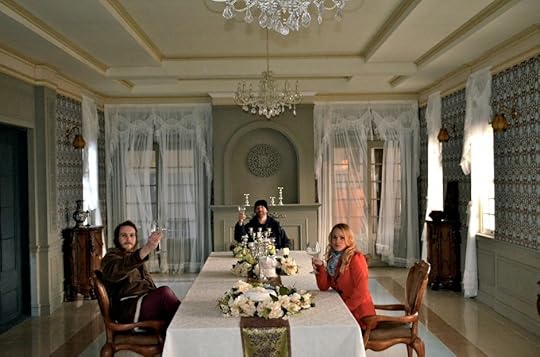
You can be forgiven for believing that the dining room is still functional.
An abandoned circus
Because of this experience, my appetite was whetted. I wanted to see more places like this, to feel that same rush of excitement you feel when you have something amazing all to yourself. The next place we found was an abandoned circus. A circus is a creepy place at the best of times, but devoid of humans and lighting, even more so.
We walked into the deserted arena, hallucinating dark shapes around us until our eyes slowly adjusted to the darkness. I could imagine clowns and horses dancing across the stage many years ago. With tentative steps, we explored every room, every corridor, curious and wary of what we might find. Then I came across a box that delighted me: Inside was a dragon head and clown costumes! Alone, I slipped on the headpiece and an electric blue clown outfit to hide my own clothing. Then I marched across the arena in the darkness, not responding to the calls of my friends, with the full intention of terrifying them. It made them suitably uncomfortable.

The view of the circus arena from the stands.
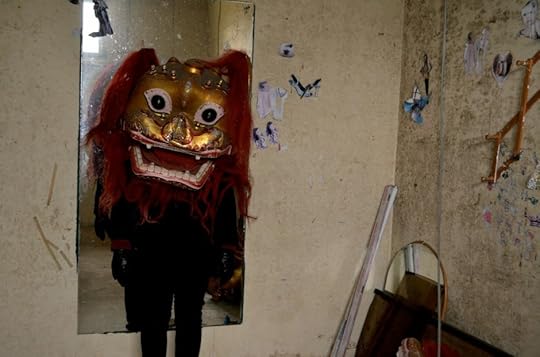
Playing dragon dress-up after using the costume to scare people.
An abandoned school
The next building we found was an abandoned school. Once again, it had been allowed to fall into disrepair, but unlike the other buildings, it had suffered huge amounts of vandalism. Every window had been broken. Was this a sign of past students wanting revenge? South Korea has one of the highest suicide rates in all the world, and the intense education system is a major cause of this.
Inside one of the rooms in the school, there were signs that someone had been living there and keeping large birds. This was our creepy cue to leave the place.

The main view of the abandoned school.

The room in which someone has been living and keeping birds.

From the roof of the school, you can see Hallasan, the largest mountain in Korea.
Paradise no more
The most recent abandoned building I’ve found is the jewel in the crown of discoveries. Named Paradise Hotel, it’s a luxury resort complete with spa, sauna, and outdoor swimming pools. Although all of the doors were open, we entered through the basement and found ourselves plunged into darkness amidst a maze of twisting corridors and impenetrable blackness. We had only one phone screen between us to use as a light source, and it offered little information about our surroundings.
Leaving the basement, we explored the bar, the dining room, the ballroom, and the reception area before moving on to the bedrooms. Here we found price lists. A regular room cost $370 a night while the deluxe rooms were $800 a night. This wasn’t a cheap place to stay. The rooms themselves were being invaded by nature as it battled to reclaim land it once owned, but the resort was so large that it’ll still be standing for many decades or centuries.
Entering an open door to the roof, my friend and I stood to take a harmless photo of ourselves wearing smoke masks we’d found in the hotel. A security guard appeared below and begun shouting at us. We quickly put back the smoke masks and disappeared without a trace, our adventure over for the day.

In the basement, we could see almost nothing.

Only with the magic of the camera restoring lost details were we able to see the mould and destruction around us.

The reception desk and breakfast dining area.

The view of the swimming pools and sea from the roof.
Why so many abandoned buildings?
I started to become curious about why there were so many abandoned buildings. The general consensus was that Jeju is a lucrative tourist island, so presumably many people invested lots of money building structures, only to find their ventures unsuccessful. As no one else is willing to take over an unsuccessful business, the buildings are simply left to be taken over by nature. Each individual building has its own story, and I can’t wait to find more.
My only sadness is this: I can’t help but wonder about these structures. Couldn’t they be put to better use than just sitting around doing nothing? Could you house homeless people in them (or the deprived people of North Korea, so very close at hand), make them something to be proud of? Or will they sit there unused with security guards who chase you away forever? I hope someone comes up with a good idea to reinvent these fantastic structures.
Rules for exploring abandoned buildings
Don’t steal anything. It’s not yours and theft is not okay.
Leave it as you found it. Don’t break anything — you’re only a guest.
Don’t force entry. If you do, you’re trespassing, and this is illegal.

The post Inside the eerie abandoned buildings of Jeju Island, South Korea appeared first on Matador Network.
April 1, 2014
Meet a Google Africa innovator
AND NO, this has nothing to do with April Fools’ Day. Google just announced the five most inspiring and innovative web-based projects in Africa at the Africa Connected Awards in Nairobi, Kenya.
Nqobizitha Mlilo (above) is a young Zimbabwean and one of the 10 finalists across the continent at the forefront of Africa’s technology movement. Content as a runner-up behind the five winners, who received $25,000 each (along with expert assistance from the Google team to edge them closer to realising their goals), he spoke with me about being a self-taught tech ninja, what African innovation can teach the world, and what projects on the continent you need to look out for.
* * *
D: What would you describe yourself as?
NM: I would describe myself as an artist, director, animator, lecturer, and entrepreneur. I am largely self-taught though I did study a year at ZIVA, which is a design college in Harare, as well as RanchHouse, where I studied business administration for a short while.
Where do you see Africa in tech and innovation?
I see Africa as a huge consumer in tech. A lot of leapfrogs are happening in technology. We have seen a huge wave of innovators who have used technology to create solutions for their situations. As we move forward as a continent, these ideas will be key to evolving into what we need to become in the world space.
How is it being a techie in Zimbabwe?
I often have mixed feelings about being a techie sometimes. I love technology, it’s awesome. I feel it increases productivity and efficiency. Sometimes some elements of society don’t quite see it the same way. Some feel it’s too invasive and still prefer an old school way of doing things. I often feel a disconnect between myself and other non-tech heads, but that is the point of evolution that we are currently at.
What 5 projects or innovators excite you on the continent and why?
Google Africa I think would be one of the most exciting tech movements in Africa. Having such a great company take an active involvement into the development of the tech space in Africa is really awesome.
The wave of mobile money services that have been implemented in Kenya and Zimbabwe. I feel they are truly tailor-made African solutions.
The Afrinolly mobile app is a great blueprint for implementing video on demand in Africa.
Tech Hubs like Hypercube in Harare, the SKi-Hub in Bulawayo, and the iHub in Kenya are significant movements in locking down innovative minds and giving them spaces to grow.
Broadband Internet that’s being implemented by various governments and companies across the continent is aiding in getting the continent connected and engaged.
What can tech and innovation in Africa give to the world?
I feel that tech coming from Africa will introduce a fresh perspective in attacking problems worldwide. I think Africa will surprise the world with a new take on solutions for old problems like poverty, hunger, and war.
Are innovators really going to effect progress for the average African?
I think so. Innovators are really just glorified case studies of progress. They begin to be a blueprint in the context of an African environment. They prove what’s possible. They break the rules of their environment. They challenge thinking and inspire change from an older way of looking at things.
Africa in 2020, what are you hoping for?
I am hoping for an open sourcing of intention. I feel if there is a unified thinking and plan for progress for the continent as a whole, that would move things in the right direction significantly. I think technology will act as a catalyst in that process. 
To view the winning projects check out: www.africaconnected.com.
The post Google just announced Africa’s 5 best web-based projects…meet one of the runners-up appeared first on Matador Network.
15 reasons it sucks to work at home

Photo: Citrix Online
15. Kids
If you have children, and they’re at home when you’re trying to work, you will quickly realize the mistake you’ve made in choosing a work-at-home career. Kids don’t care that you’ve got a deadline, or that you’re on the phone with an important client.
If Johnny wants to watch Monsters University (for the third time today), you’ll have to drop everything you’re doing and turn it on, or he will scream nonstop until you do. And if the adorable little hand of your precious toddler taps you on the leg and he lovingly says to you, “play, mommy” — you will have to play. If you don’t follow him to the designated play area right then, that precious little hand will grab your computer’s mouse and hurl it across the room.
14. Facebook — and Twitter, and Instagram, and Pinterest
You name it, the social networks that have revolutionized the way we communicate with one another have also destroyed all productivity. You could be working on that big deadline project, decide to check your social network of choice “real quick,” and fall down the rabbit hole. You see, it will not be “real quick;” you will keep diving deeper into the pool of timesuck that is social media.
13. Food — everywhere
If you’re at an office, you long for lunchtime, when you can devour your carefully portioned meal in the 30 minutes you have to eat. If you’re at home, you have complete control over when you eat, and for how long, and how much. And you will eat constantly because you have access to your kitchen 24/7.
12. Work-at-home slobbery
When work is home, you basically get out of bed and get to work. You no longer worry about what you’re going to wear, if your skirt is too short, or if your tie matches your suit jacket. Nobody can tell you not to wear flannel jammies to your computer desk, or to brush your teeth. So you don’t. Some days, you may not even brush your hair. You’re disgusting!
11. Losing touch
When you work outside the home, you make friends and socialize with them in public. When you work at home, you hang out at home. With yourself. Not only can it be lonely, but you forget what it’s like to be around people.
So when you inevitably do go to a social event, or even to the grocery store, you may find yourself doing either of the following two things: talking to everyone you see about the rising cost of milk (it’s expensive!), or at the other extreme, staring wide-eyed in shock at the nice old lady who said “excuse me” as she passed your cart too close.
10. Pets
Like kids, if you have a pet, you know what it’s like to have constant interruptions. Dogs need to be fed and walked; cats like to walk all over your computer and sometimes sleep on your arm. And they are relentless in their pursuit of getting your attention.
9. Housework procrastination
There’s dust on the TV stand. There are dirty dishes in the sink, and you need some clean towels. Any minor distraction can snowball into a day of cleaning or organizing when you’re at home all day, every day. You’ll want to clean that mess up, and you won’t be able to get to the work you’re paid to do until you clean it.
8. Sunshine
One advantage to working in a cubicle is that you can’t always see the weather outside. But when you’re at home, and the sun is blinding you through the windows, it’s pretty difficult to resist the urge to play outside.
7. Snow days
Ah, the Polar Vortex. While it stranded thousands in their homes or cars this winter, kids and workers alike were singing its praises because they didn’t have to go to school or work. But someone who works from home? Expected to work.
6. Neighbors
If you live in an apartment, and the people who live above you either work third shift, or they also work at home, or not at all, they will be noisy. They will annoy you with their noisiness when you’re trying to work.
If you live in a house, and you can see out of your windows, you will inevitably wonder what the neighbors are up to, and sometimes find yourself staring at them and creating lives for them. Some may call it obsessing, but I call it “being informed.”
5. Milk runs
“Can you get some milk?” Others will assume that since you’re working from home, you have plenty of time to run errands. But you don’t. You’re WORKING.
4. The ire of other parents
If you have kids, mothers who have to work outside the home will target you with their resentful stares, because they believe you’re “lucky” to “get” to stay at home with the kids, while they’re away from them all day. Weekend playgroups will therefore be filled with tension.
3. Can’t “leave it at the office”
Because your office (laptop) is right next to you on the couch. If there’s work to do, you can’t just let it go until Monday morning, because it never leaves you. Which is why you work on Saturday nights, while the world parties. Or sleeps.
2. Missing shaving your legs/face
Or wearing heels, or a stuffy suit, or a uniform. There will come a day when you look at yourself in a mirror, ponytail askew, sweatshirt stained, gym shorts full of holes, and you will wish you could wear your Louboutins — if only for a few hours.
1. Never wanting to go back to an office job
It’s true. All of the positives of working at home still outweigh the negatives, and if the opportunity arises to leave your work-at-home job, you’ll feel conflicted. You might even realize it doesn’t really suck, even if it is work. 
The post 15 reasons it sucks to work from home appeared first on Matador Network.
Matador Network's Blog
- Matador Network's profile
- 6 followers



